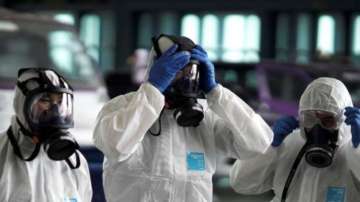Scientists detail early lung infection in COVID-19 patients
A global team of researchers has for the first time described the pathology of early phase of lung infection in coronavirus (COVID-19) patients who were alive.

A global team of researchers has for the first time described the pathology of early phase of lung infection in coronavirus (COVID-19) patients who were alive.Two patients who were part of the study underwent lung lobectomies (surgery to remove one of the lobes of the lungs) and were retrospectively found to have had COVID-19 at the time of surgery.
Pathologic examinations revealed that, apart from the tumours, the lungs of both patients exhibited edema, proteinaceous exudates (fluid), focal reactive hyperplasia of pneumocytes with patchy inflammatory cellular infiltration, and multi-nucleated giant cells.Fibroblastic plugs were noted in airspaces.
"This is the first study to describe the pathology of disease caused by COVID-19 pneumonina, since no autopsy or biopsies had been performed thus far," said Shu-Yuan Xiao, from the University of Chicago Medicine in Chicago.
"This would be the only description of early phase pathology of the disease due to this rare coincidence. There would be no other circumstance that this will happen. Autopsies will only show late or end stage changes of the disease," Xiao mentioned in a paper published in the Journal of Thoracic Oncology.For the study, Xiao teamed up with a small group of clinicians from the Zhongnan Hospital of Wuhan University in Wuhan, China.
"Since both patients did not exhibit symptoms of pneumonia at the time of surgery, these changes likely represent an early phase of the lung pathology of COVID-19 pneumonia," Dr Xiao added.The first case was a female patient, 84, who was admitted for treatment evaluation of a tumor measuring 1.5 cm in the right middle lobe of the lung.
She had a past medical history of hypertension for 30 years, as well as type 2 diabetes. Despite comprehensive treatment, assisted oxygenation, and other supportive care, the patient's condition deteriorated, and she died.
Subsequent clinical information confirmed that she was exposed to another patient in the same room who was subsequently found to be infected with the 2019 novel coronavirus."Case 2 was a male patient of 73 years of age, who presented for elective surgery for lung cancer, in the form of a small in the right lower lobe of the lung," said the authors.
Nine days after lung surgery, he developed a fever with dry cough, chest tightness, and muscle pain. A nucleic acid test for COVID-19 came back as positive. He gradually recovered and was discharged after 20 days of treatment in the infectious disease unit.
According to the study, these two incidences also typify a common scenario during the earlier phase of the virus outbreak, during which a significant number of healthcare providers became infected in hospitals in Wuhan, and patients in the same hospital room were cross-infected, as they were exposed to unknown infectious sources.
The presence of early lung lesions days before the patients developed symptoms, corresponds to the long incubation period (usually 3-14 days) of COVID-19, making it difficult to prevent transmission during the early days of this outbreak, as many healthcare workers in Wuhan became infected, when they were seeing patients without sufficient protection, according to Dr Xiao.
More than 15 doctors in Wuhan died of COVID-19, from infections while they were taking care of patients.Some of them were previously healthy and as young as 29 years old.
Also read: Wrestling: COVID-19 sees indefinite postponement of Asian Olympic qualifier
Also read:Low levels of COVID-19 found in Hong Kong patient's pet dog